The LED light source has advanced past many manufacturing, assembly, and energy efficiency hurdles that once impeded progress in solid-state lighting (SSL). A decade ago, Chuck Swoboda — whose career in the LED and SSL supply chain has included a lengthy tenure at LED manufacturer Cree — commented that he hoped LEDs would be penetrating the lighting market at 80% by 2015, rather than the 2020 timeframe cited by an audience member during a seminar Q&A.
Meanwhile, nearly one year ago, chief editor Maury Wright observed that the retrofit of lighting with LED sources (known as “LEDification”) hit 30% penetration, leaving 70% for new LED business opportunity. Furthermore, he wrote, the second phase should already be underway to replace earlier projects with improved quality SSL. So why is there still such a broad opportunity for the penetration of LEDs into the built environment? What’s holding back the long-hailed revolution in lighting?
At first glance, the title of our upcoming virtual event, “Renaissance of light quality: SSL industry swaps focus from efficiency to architecture,” doesn’t quite appear to be the venue for such questions. That would be a misconception that will be addressed in depth during the Closing Plenary panel. The subtitle of the panel — “The lighting industry needs a revolution, before it’s too late” — pulls no punches. The premise is that although the lighting sector now has the ability to address light quality gains and ambitious integration of SSL, failure to innovate in the business will cause contraction and impede profitability as well as ingenuity.
The Closing Plenary panel will be led by Michael Kershner, CEO of Innovative Lighting Consultants, who just happens to be one of our 40 Under 40 honorees. Kershner approaches the management of his firm based on technology and process automation to merge the lighting design and procurement processes, freeing up more resources for creative thinking and innovative application of LEDs. Panelists include other established and outspoken players in the industry: lighting designer Chip Israel, CEO and founder of Lighting Design Alliance; Sero Cardamone, senior vice president, sales, Acuity Brands; and Swoboda, who is now president of Cape Point Advisors and innovator-in-residence at Marquette University.
When asked about the tone of the panel and what is holding back SSL from its full implementation, Kershner noted that the concept of Overton’s Window applies to the issue. “The idea is that what seems radical to one group, but is status quo to another, will without question become status quo to the masses,” he said. “The lighting industry for the most part has accepted [LED] as status quo, but we have not done a good enough job educating the masses on the differences and advantages.” In turn, he concluded, projects that are not coordinated and specified by LED-savvy professionals may not even fully include LEDs in a planning discussion because “what actually gets purchased and installed rather than specified on projects is done by distributors, reps, and contractors. All of their inherent focus is to sell product that will not require much work. Our industry as a whole has not made specifying and installing LED products — especially system-based products — very easy,” said Kershner.
This certainly doesn’t cover the entire scope of the Closing Plenary. Kershner said topics will run from the need to move beyond the manufacturing design concept of “putting light bulbs in metal boxes,” to providing better service after implementation to incentivize uptake, to how streamlining processes with automation will improve productivity, freeing up more time for creativity and value proposition conversations with clients.
For a more engaging twist on the typical panel discussion, the participants will deliver short presentations interspersed with audience polling and Q&A discussion. We anticipate that the more interactive format will allow both the attendees and the panelists to lock on to these chief concerns and questions the lighting community, to tackle them in a collaborative way, simultaneously advancing innovation in technology implementation and business practices.
The Closing Plenary will begin at 4:00 PM ET on Sept. 30. Visit the Renaissance of light quality registration page and join us for two days of intensive and focused education, free to attend. You’ll find the full program at the registration page so you can sign up for the individual sessions.
For up-to-the-minute LED and SSL updates, why not follow us on Twitter? You’ll find curated content and commentary, as well as information on industry events, webcasts, and surveys on our LinkedIn Company Page and our Facebook page.





